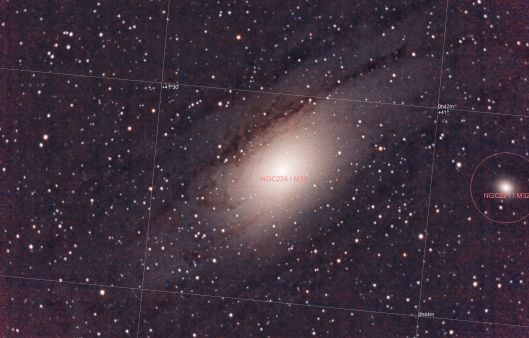Tags
A while ago I took another picture of Andromeda Galaxy, using the telescope. My previous picture was only with the zoom lenses. Eventhough I knew Andromeda didn’t fit on the picture frame, I thought it would be a good idea to make it with more details.
 Andromeda Galaxy (M31) and M32
Andromeda Galaxy (M31) and M32
Celestron AVX 8″ SCT
Filter: Astronomik CLS-CCD
Focal Length: 1278 mm
Aperture: f/6.3
ISO: 1000
Shutter: 30s / 60s / 120s
Stacking: 17 / 22 / 8
Total exposure: 46,5 min
Aquisition: BackyardEOS
Post processing: PixInsight
Taken Oct 27, 2014 around 23:35 CET
First post-processing I did looked very nice, but i found out in the last steps that there was some very nasty artifacts on the picture. Seems like when reading one for the shots, the external HDD hiccup and corrupted the data of one file, messing up the result. So I had to re-process everything, and the second result is not as pleasing as the first.
Anyway, lately I am trying out Maxim DL. Pretty powerful piece of software, can control everything from the camera, telescope, autoguiding, to weather station, dome, focus and filters. It is not easy to use, but I am trying it out. And doing so, I discover some nice algorithms that analyze the picture and find where in the sky it is.
And it seems that Pixinsight also have one of if. So i tried to Plate Solve my image, it finds the celestial coordinates the picture belong, and then Annotate the image with a celestial grid, and some data of what is inside it.
Annotated Andromeda Galaxy
The annotation can be very simple, as it is in this example, or very detailed. With star names, constellations, and much more. Not all my pictures works to Plate Solve and Annotate, maybe because they have always too much field rotation. But it is a nice feature.
Vote in me for astrophotography award:


